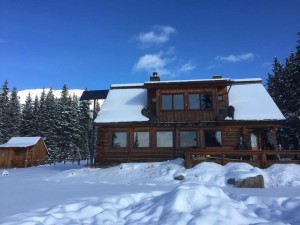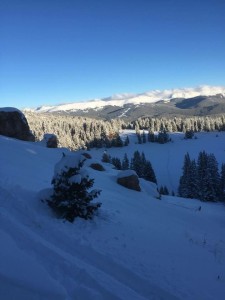Colorado is full of solitary wilderness areas that are begging to be explored by Colorado College students. Adventures into the mountains of Colorado don’t have to stop after the fall has come to a close. When the mountains turn white and the days get shorter, many CC students will flock to I-70 corridor to get their snow fix. I-70 boasts some world-class ski resorts—there is no denying that. But at the end of the day, is it really worth driving five or six hours on a Saturday for three to four hours of skiing?
As I found out over Thanksgiving Break, taking the road less travelled to a 10th Mountain Division Hut can make all the difference in a weekend snow experience. While hordes of skiers descended upon Breck, Keystone, and A-Basin, my family and I headed to the 10th Mountain Division Hut, just outside of Leadville, Colo. The 10th Mountain Division Hut system is a series of 13 cabins nestled in the mountains of Colorado, mostly within two to three hours drive from CC. The 10th Mountain Division Huts were first built to train soldiers who were deployed to the Alps during WWII.
Hut trips are the polar opposite of a crowded Saturday at a Vail Resort. Instead of lift lines, you are greeted with solitude and pristine beauty. You won’t be making as many turns as on a resort day, but the rewards of going on a hut trip far outweigh any positives of an early-season day at Breck or Keystone.
One of the most accessible and remote huts in the system is confusingly named the 10th Mountain Hut. Others sport names such as Uncle Bud’s or Margy’s. There are some that can be accessed by snowmobile, but the 10th Mountain Ski Hut requires users to ski or snowshoe to the cabin. The total mileage, starting from Crane Park trailhead, is 5.7 miles. It’s just long enough to make the sight of the cabin at the end of the hike a welcome relief. Some of the most difficult huts to reach, such as Skinner Hut, require a 10.6-mile hike with serious elevation gain.
 After a bit of a debacle with my family, I have a couple of insights to share about how to have the best hut experience possible. It seems elementary, but my number-one tip is to bring a map. My brothers and I set off from the car with the idea that we could follow the tracks of three groups that had headed up to the cabin before us. Big mistake. We veered off trail and ended up following the tracks of the early groups to a lake above the hut. We couldn’t see the hut, and the sun was going down. It was beautiful up there, but the idea of spending the night out in sub-zero temperatures in a snow cave tempered my excitement of being in a pristine basin. After 20 minutes of indecision and nervous discussion, we stumbled across the hut and the rest of our group. The group shared some beers, smiles, and laughs. It was a close call. All of our late-afternoon drama could have been avoided by bringing a map and the detailed route description that is available at huts.org. Packed down ski tracks often look inviting because skiers have gone both up and down the trail once they realize that they are off-trail.
After a bit of a debacle with my family, I have a couple of insights to share about how to have the best hut experience possible. It seems elementary, but my number-one tip is to bring a map. My brothers and I set off from the car with the idea that we could follow the tracks of three groups that had headed up to the cabin before us. Big mistake. We veered off trail and ended up following the tracks of the early groups to a lake above the hut. We couldn’t see the hut, and the sun was going down. It was beautiful up there, but the idea of spending the night out in sub-zero temperatures in a snow cave tempered my excitement of being in a pristine basin. After 20 minutes of indecision and nervous discussion, we stumbled across the hut and the rest of our group. The group shared some beers, smiles, and laughs. It was a close call. All of our late-afternoon drama could have been avoided by bringing a map and the detailed route description that is available at huts.org. Packed down ski tracks often look inviting because skiers have gone both up and down the trail once they realize that they are off-trail.
Other essentials for the trip include the normal list of items for a backcountry trip. You’ll want to bring a sleeping bag, toiletries, and relatively light food. The lighter the food you bring, the more liquid you can carry up. Liquid is important because both beer and water will sustain you. One item that you would not think to bring is a pillowcase. My brother got pink eye from one of the pillows—he claims—so it is probably a good idea to bring a pillowcase.
Overall, it’s pretty hard to have a bad hut trip. You’ll be with your good friends in a beautiful place far, far away from the gapers of I-70. Take the road less travelled over your next Block Break and go check out a true Colorado gem at the 10th Mountain Hut.
David Andrews
Latest posts by David Andrews (see all)
- $700 Million and Counting: What You Need to Know About the Endowment – Dec 17, 2016
- Colorado College President Jill Tiefenthaler – Dec 17, 2016
- English Professor Natanya Pulley – Dec 3, 2016

